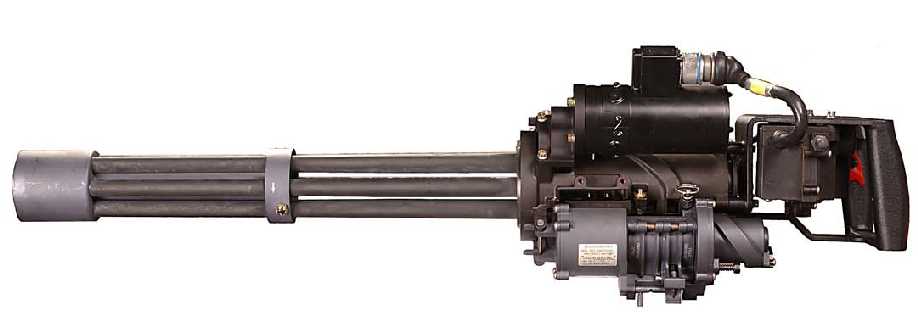
Photograph copyrighted by Dillon Aero, Inc..
Developed by General Electric in the early 1960s, the "Vulcan" series of miniguns is available in many calibers from 5.56 mm (0.223 in) up to 25 mm (1.0 in). The 0.30 caliber (7.62 mm) GAU-2 version was first deployed by the Air Force for use on light aircraft and helicopters, but has since been adopted by the Army, Marines and Navy for the same purposes. These guns are widely used, with the U.S. Army alone purchasing over 9,500 M134 guns. The US Navy uses these weapons on ships to supplement the 25 mm Chain Gun and venerable 0.50-caliber "Ma Deuce" M2 BMG.
The term "Vulcan" was originally the GE Project Name for the first Gatling-type electric-powered minigun and is now a slang term for all of these electric Gatling guns.
The GAU-17/A gun system consist of a six-barrel rotary gun, a gun control assembly with electrical cables, gun drive motor unit, a delinking feeder, flexible ammunition feed chutes and an ammunition storage system. Gun component parts, such as the rotor, housing, feeder/delinker, and barrel clamp/flash suppressor, are available in either steel or lightweight titanium.
Quoting from a USMC HMLA OAG Action Item: "The GAU-17 minigun, while providing [an] outstanding volume of fire, is notorious for jamming." Most of the problems occur in the Feeder/Delinker assembly. One manufacturer of this weapon, Dillon Aero, Inc., claims its Feeder/Delinker design is much more reliable with an average of 30,000 rounds between stoppages.
This weapon is also used on surface warships in the British Royal Navy.
| Designation 1 | Army - M134D
Air Force - GAU-2B/A Navy - GAU-17/A |
|---|---|
| Ship Class Used On | Many |
| Date Of Design | about 1963 |
| Date In Service | 1965 |
| Gun Weight | 35 lbs. (16 kg) |
| Gun Length oa | 29.5 in (75 cm) including suppressor
Barrels are 22 in (55.9 cm) long |
| Bore Length | N/A |
| Rifling Length | 20 in (50.8 cm) |
| Grooves | 4 |
| Lands | N/A |
| Twist | Uniform RH 1 in 33.333 |
| Chamber Volume | N/A |
| Rate Of Fire | 2,000 to 4,000 rounds per minute 2 3 |
- ^M134D is the minigun itself. Other designations are usually for the "gun assemblies" that include the mounting.
- ^Barrel cluster rotates counterclockwise as viewed from the breech end.
- ^The original design of the 1960s had a fixed rate of about 6,000 rounds per minute. This was unsustainable over any period of time and the weapon was redesigned to add a transmission housing at the motor, giving the weapon a variable speed of 2,000 or 4,000 rounds per minute. On the newer Dillon Aero Inc. version, the rate of fire is determined by the gun drive unit used, with drive units giving either 3,000 or 4,000 rounds per minute available. There is no speed selection on this version other than by assembling a different gun drive motor to the the gun system assembly. The 3,000 ROF drive motor takes 0.5 seconds to spin up to speed and 0.25 seconds to spin down to stop. When the trigger is released, there is a delay until all six barrels have been cleared by fire. This ensures that no live ammunition is left in the firing chambers, thus eliminating cook-off problems.
| Type 1a | Fixed |
|---|---|
| Weight of Complete Round | Ball - N/A |
| Projectile Types and Weights | Ball - 0.34 oz (9.65 gm) |
| Bursting Charge | None |
| Projectile Length | N/A
Complete Round - 2.75 in (6.99 cm) |
| Propellant Charge | N/A |
| Cartridge | 7.62 x 51 mm |
| Muzzle Velocity | 2,800 fps (854 mps) |
| Working Pressure | N/A |
| Approximate Barrel Life | 100,000 rounds per barrel cluster |
| Ammunition stowage per gun | Up to 4,400 rounds of ready ammunition 2a |
- ^These guns use standard NATO 7.62 mm percussion primed ammunition which is usually supplied in in 1,000 round disintegrating-link belts.
- ^Magazines are available in various sizes:
1,500 rounds: Empty 24.4 lbs. (11.1 kg), Full 125 lbs. (56.8 kg)
Standard 3,000 rounds: Empty 27.0 lbs. (12.25 kg), Full 208 lbs. (94.5 kg)
HMMWV 3,000 rounds: Empty 24.4 lbs. (11.1 kg), Full 204 lbs. (93 kg)
4,400 rounds: Empty 31.0 lbs. (14.1 kg), Full 295 lbs. (134 kg)
| Elevation | Range |
|---|---|
| Maximum Range | about 1,100 yards (1,000 m) |
| Designation | Single Mountings
Mark 16 - Naval Post Mount GAU-17/A - Aircraft Mount |
|---|---|
| Weight | Total System Weight - (less ammunition, battery and mount)
Steel, fixed forward fire: 56.9 lbs. (25.8 kg) Titanium, fixed forward fire: 45.1 lbs. (20.5 kg) Steel, crew served: 66.1 lbs. (30.0 kg) Titanium, crew served: 53.13 lbs. (24.1 kg) |
| Elevation | N/A |
| Elevation Rate | Manual operation, only |
| Train | 360 degrees |
| Train Rate | Manual operation, only |
| Gun recoil | N/A |
Unit requires 24 - 28 Vdc, 58 amps to operate. A Vac power supply option is also available.
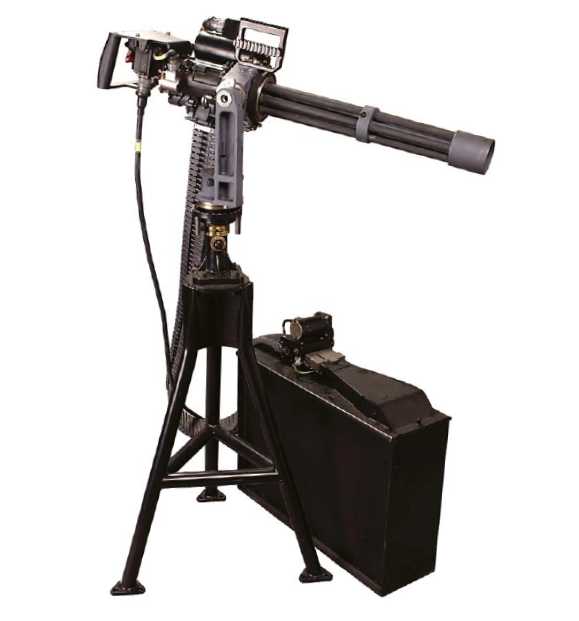
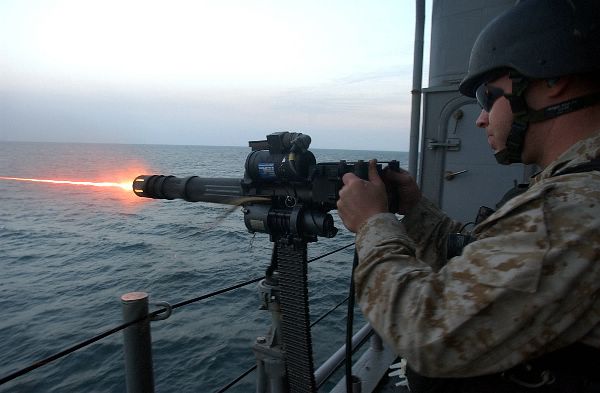
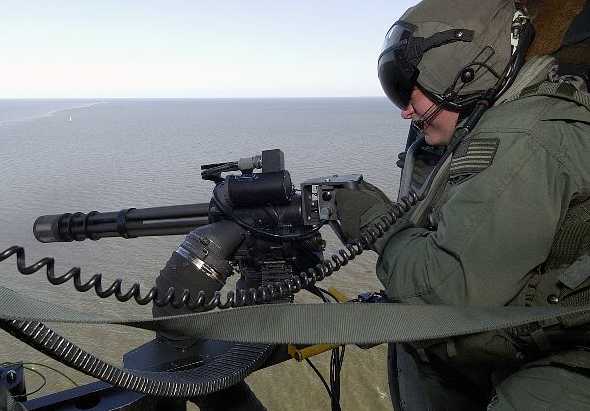
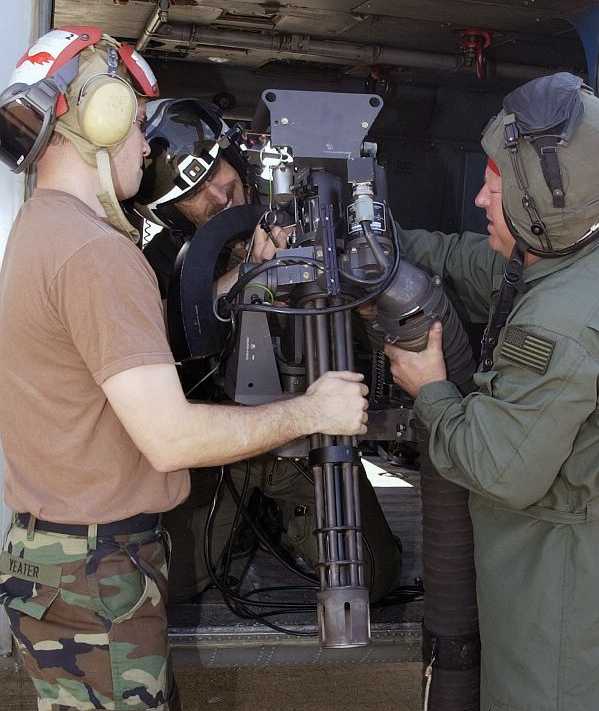


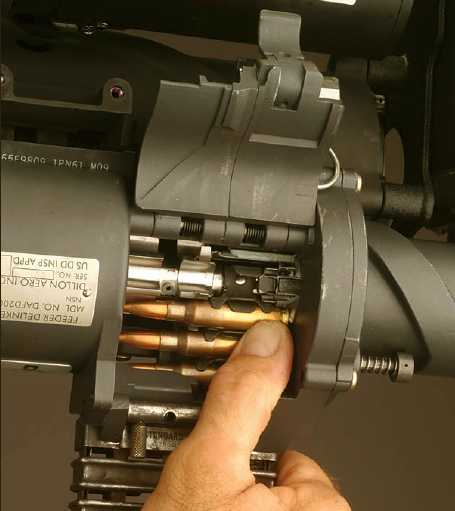
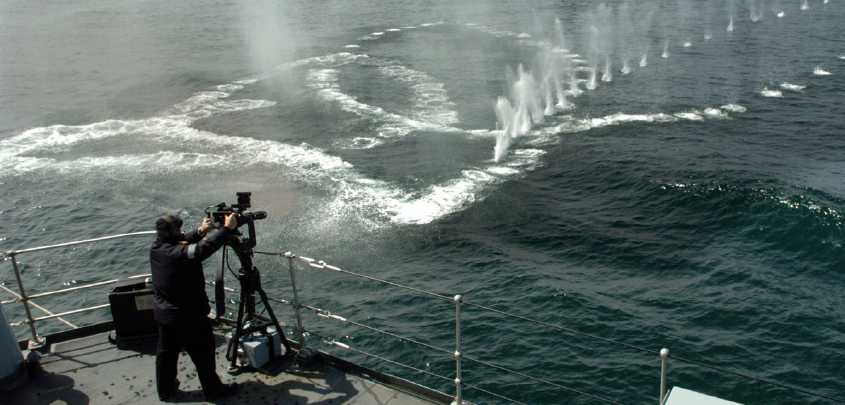
"The Naval Institute Guide to World Naval Weapon Systems 1991/92" by Norman Friedman
"Jane's Ammunition Handbook: Ninth Edition 2000-2001" edited by Terry J. Gander and Charles Q. Cutshaw
---
"M134D Minigun Product Information Guide" by Dillon Aero, Inc.
---
U.S. Army Deputy, Integrated Logistics Support Center
U.S. Navy Press Releases
USMC HMLA OAG Action Item 1997-40
---
Special help by Leo Fischer
30 October 2006 - Benchmark
20 February 2009 - Corrected typographical error
10 August 2016 - Converted to HTML 5 format
28 November 2020 - Reorganized notes, updated to latest format, updated links
